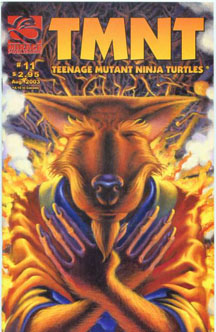Peter Laird’s decision to have “Teenage Mutant Ninja Turtles” Volume 4 unfold at a leisurely pace, reflecting real life rather than an action movie, frustrated a lot of readers when these issues came out at two-month intervals. But as I get further into re-reading this volume, I think the approach is paying off.
Reflecting on Splinter
In Issues 10-11, Splinter’s death and funeral are poignant because of how “real world” they are. At the same time, this grand story’s sci-fi aspects – talking velociraptors dining on Utroms in Venezuela – carry more weight because of the down-to-earth elements they are interspersed with.
From the beginning, Splinter talked about dying so much that it’s kind of remarkable he made it to 2003. Only 18 pages into Volume 1, Issue 1, Splinter tells his sons: “Now, I am old, and there is a task I would have you perform before I leave this life.” A reader half expects Splinter to die with a smile on his face when the Turtles return with news of the Shredder’s demise, as if he were hanging on just for that news.

“Teenage Mutant Ninja Turtles” Vol. 4 Issues 8-13 (2003)
Writer: Peter Laird
Pencils: Jim Lawson
Inks: Peter Laird, Eric Talbot
Through most of Volume 1, Splinter is underexplored, although he has interesting moments — fending off death by eating rats at the urging of the Rat King’s ghost in “City at War” and then seemingly dying at the hands of one of his sons in a flash-forward in Volume 2, Issue 1.
His actual death, though, is beautiful for its normalcy and Jim Lawson’s artistic portrayal. Splinter dies of an apparent heart attack after feeding a cat and a bird at the Northampton farm. The montage closes with the cat eating the bird – and the cycle of life continues. The panel where the Rat King’s ghost appears in a doorway of the farmhouse is masterfully drawn; I may have said “Wow!” out loud when I spotted him lurking there.
At the funeral, Leo sums up his father nicely:
“He gave us a foundation of honor and compassion which has served us well. He wasn’t perfect, though he came as close to it as anyone I’ve ever met.”
It also strikes me that this riverbank funeral in broad daylight is a nice side effect of mutants and aliens being accepted members of society now, as we see a large mix of family and friends, including a last-second surprise visit from Renet.
Rivalry of the species
That having been said, Laird seems interested in exploring speciesism. The movie “Ghost World” posited that racism doesn’t go away with time, people just get better at hiding it. Along those lines, I’d argue that some humans’ racism/speciesism has been exposed thanks to the Utrom visit, and now they have to get better at hiding it again.

In Issue 9, a nice young girl meets Don on the sidewalks of New York. After they shake hands and part ways, the girl’s mom says, “Rachel, I can’t believe you touched that … thing. Hold still while I clean your hand.” More overtly, in Issue 10, the Madhattan Maulitia gears up for “xihad” (xenoform jihad), including blowing up an Utrom building.
Moments of stark bigotry and violence like that make the sci-fi stuff work better. Whereas the Turtles’ extraterrestrial adventures in early Volume 1 were a fun romp without any deep thematic context, everything in Volume 4 carries more weight because of the illuminating Utrom-visitation backdrop.
While I find the dinosaurs eating the Utroms (“juicy little meatssesss”) in Issue 9 quite amusing, I also think the sequence packs a decent horror-movie punch. It seems that decades down the line, the Utroms’ mutagen that transformed Splinter and the Turtles also led to talking dinosaurs.
Obviously, there are more pieces to this puzzle (perhaps tying back to the “Tales” Issue 7 dino-times story?), but it’s safe to say this “secret of the ooze” is more compelling than the movie franchise’s “It was an accident.”
Also on the front burner among hot mysteries: April (who recently learned she is not genetically related to her sister, Robyn) finds an old home filmstrip of her dad sketching pictures of her – before she was born!
Going digital
Speaking of art, Volume 4 switches from the classic Mirage pencils-inks-tones approach to a digitally toned look with Issue 9. This crisper, but sometimes less vibrant, style will carry throughout this volume and “Tales of the TMNT” Volume 2, which would start in January 2004. I like the classic look better, but the new look is easy enough to get used to, and when I’m caught up in a good story, I don’t even think about it.
Volume 4 is a good story so far. Laird is not aggressive with characterization the way Gary Carlson was in Volume 3 – for example, there, Mike was a published novelist; here, he’s a Big Apple tour guide for newly arrived aliens.
Nonetheless, I care about what happens to everyone in this story, and I think Laird’s deliberate pacing and mysteries are the reasons for that.

